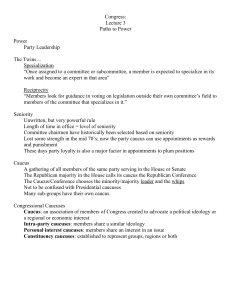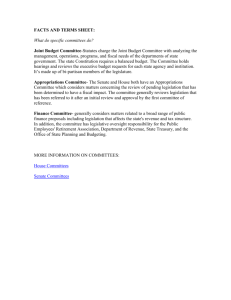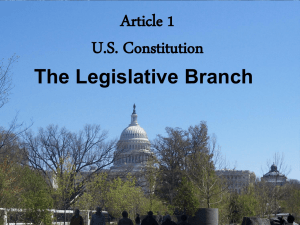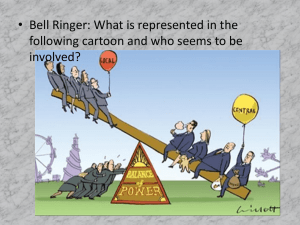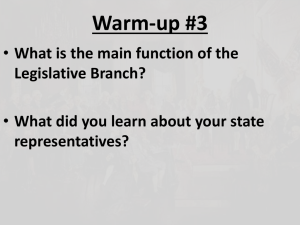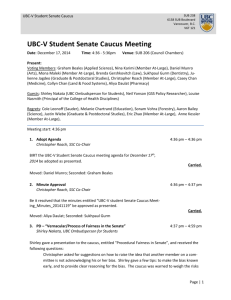POLS 205 American National Government Unit 2, Lecture 3: Our
advertisement
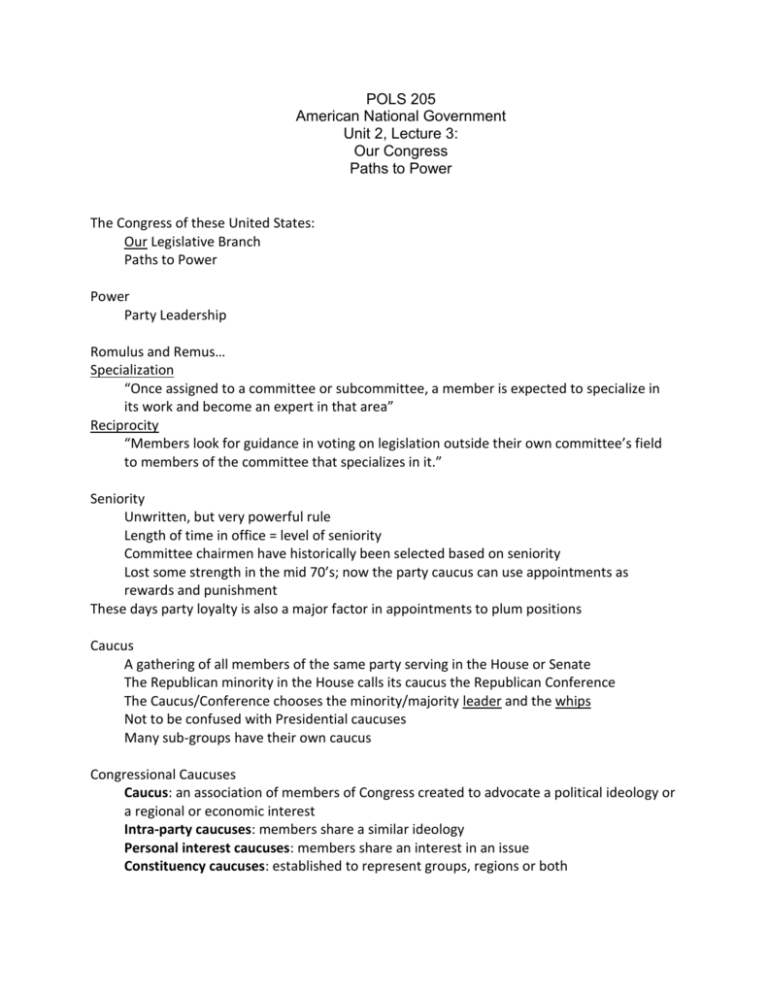
POLS 205 American National Government Unit 2, Lecture 3: Our Congress Paths to Power The Congress of these United States: Our Legislative Branch Paths to Power Power Party Leadership Romulus and Remus… Specialization “Once assigned to a committee or subcommittee, a member is expected to specialize in its work and become an expert in that area” Reciprocity “Members look for guidance in voting on legislation outside their own committee’s field to members of the committee that specializes in it.” Seniority Unwritten, but very powerful rule Length of time in office = level of seniority Committee chairmen have historically been selected based on seniority Lost some strength in the mid 70’s; now the party caucus can use appointments as rewards and punishment These days party loyalty is also a major factor in appointments to plum positions Caucus A gathering of all members of the same party serving in the House or Senate The Republican minority in the House calls its caucus the Republican Conference The Caucus/Conference chooses the minority/majority leader and the whips Not to be confused with Presidential caucuses Many sub-groups have their own caucus Congressional Caucuses Caucus: an association of members of Congress created to advocate a political ideology or a regional or economic interest Intra-party caucuses: members share a similar ideology Personal interest caucuses: members share an interest in an issue Constituency caucuses: established to represent groups, regions or both Leadership Organization Institutional Leadership vs. Political Leadership House Speaker Selected every two years Often serves for many years Nancy Pelosi (CA) Majority Leader Party Leader 2nd in command Steny Hoyer (MD) Senate Majority Leader The person in charge Party Leader Harry Reid (NV) President Pro Tempore Honorary, based on seniority For the time being Robert Byrd (WV) Presiding Officer - Vice President Presides – but not often Breaks ties (6 months for Cheney) Joseph Biden (D) Delaware http://www.senate.gov/pagelayout/senators/a_three_sections_with_teasers/lea dership.htm Majority and Minority Leadership Majority Leader – Political Leader Steny Hoyer (MD) House; Harry Reid (NV) Senate Minority Leader – I’d be the boss if WE were in charge John Boehner (OH) House; Mitch McConnell (KY) Whips – coordinate party positions Name comes from English fox-hunting “Whipper-in” keeps dogs from running away Counts votes Keeps votes in line Count noses and twist arms Party Loyalty 80%! Mavericks: members who show less loyalty to their party and do not abide by informal rules Now, not a single chairman in either side believes they are there because of the leadership. (Dick Army) The Floor Calendar – list of bills scheduled for hearing or vote Majority, Super Majority The Well C-Span Filibusters Unlimited debate Used to slow down progress of a bill you don’t care for. Very effective late in session when time is short. Senate Only (too many members in the House…) Rule 22 requires 3/5th of the Senate (60) to invoke… Cloture, which is a vote to end the debate. Congressional Staff Constituency service is a major task of members’ staff Legislative functions of staff include devising proposals, negotiating agreements, organizing hearings, and meeting with lobbyists and administrators Members’ staff consider themselves advocates of their employers Staff 35,000 employees Committee staff has declined in recent years under Republican control (House: 1,407 from 2,100; Senate: 950 from 1,185) Minimum personal staff: 18 full time, 4 part time Wasserman: they “organize hearings, negotiate… research… speak with voters, and promote legislation.” They initiate policies and “sell” them to their bosses. Elected Staff? Clerk Sergeant at Arms Chaplain Executive/Legislative Tension Even if the House, the Senate and the President ALL come from the same party, and certainly if they do not, Even if the President (and/or the Vice President) was recently part of the Legislative Branch, Even if the President has a substantial mandate of public support, They trust each other “as far as I can throw ‘em…” Other Powers Advise and Consent: Confirming and Ratifying The Senate Confirms the President’s Appointments Judicial Executive Diplomatic They can delegate the authority to fill certain “inferior” positions without confirmation Again, committees do the work A major component of checks and balances The Senate Must Ratify all Treaties Foreign Relations Committee A major component of checks and balances The Executive retains the power of initiative on this. (Can you say Kyoto?) Oversight We brought you into the world and we can take you out! (But they never do…) General Accounting Office (The GAO) Examines governmental programs and departments Looks for fiscal efficiency, consistency with legislative intent, and legality of operations Analogous to Legislative Auditors at the state level Investigation Congress can investigate whatever it wishes! Often viewed as a grandstanding, partisan activity Oh yeah, this really helps with legislative/ executive tension! Joe McCarthy and the House Un-American Activities Committee Impeachment The House impeaches; the Senate holds the trial Johnson 1868 Clinton 1998 Impeached but not convicted Nixon 1974 Resigned instead of facing impeachment Federal Judges can be (and have been) impeached (and convicted) The War Powers Act Congress has not used its constitutional power to declare war since 1941 Criticism of the President’s role in Vietnam led to the War Powers Act of 1973 The President may only commit troops abroad for a period of 60 days, (90 if including withdrawal) Congress must approve a longer period Nixon vetoed it, they over-rode the veto Presidents don’t like it, but tend to go for some sort of authorizing resolution from Congress Remember, no matter what, Congress still funds things! The Incumbency Advantage Media coverage is higher for incumbents Incumbents have greater name recognition due to franking, travel to the district, news coverage Members secure policies and programs for voters (Pork) Re-apportionment is friendly to incumbents Figure 13.1 Percentage of Incumbents Reelected to Congress Next: Money, Power and Other Impolite Things
